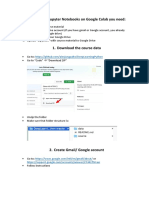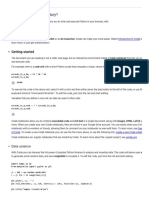0% found this document useful (0 votes)
47 views11 pagesIntroduction To Google Colab
Google Colab is a cloud-based Jupyter Notebook environment that allows users to run Python code for free, with access to GPUs and TPUs. It offers features such as integration with Google Drive, collaborative coding, and basic operations like running shell commands and working with datasets. Users can get started by signing in with a Google account and can utilize best practices to manage limitations like session time and resource constraints.
Uploaded by
xerholatCopyright
© © All Rights Reserved
We take content rights seriously. If you suspect this is your content, claim it here.
Available Formats
Download as PPTX, PDF, TXT or read online on Scribd
0% found this document useful (0 votes)
47 views11 pagesIntroduction To Google Colab
Google Colab is a cloud-based Jupyter Notebook environment that allows users to run Python code for free, with access to GPUs and TPUs. It offers features such as integration with Google Drive, collaborative coding, and basic operations like running shell commands and working with datasets. Users can get started by signing in with a Google account and can utilize best practices to manage limitations like session time and resource constraints.
Uploaded by
xerholatCopyright
© © All Rights Reserved
We take content rights seriously. If you suspect this is your content, claim it here.
Available Formats
Download as PPTX, PDF, TXT or read online on Scribd
/ 11

























































